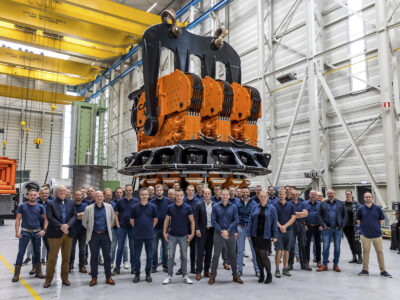
Monopile Decommissioning
MONOPILE DECOMMISSIONING
Common practice taken from the oil and gas industry is to remove as much of a structure as possible and either leave some of it above the seabed in deep water. At shallower water the structure normally has to be removed completely but the foundation piles can then be cut a few meters below the seabed with the rest left in the soil. Either way, remains are left behind and may cause obstructions later on when the seabed needs to be used for something else. Although in the oil and gas industry this was very unlikely and therefore not seen as a problem but with the offshore renewables this is a completely different story.
After the lifetime of a wind farm it is very likely that the same site will be re-used for a new wind farm, possible with larger turbines or in the future with structures we can’t even imagine at the present time. So leaving anything behind after decommissioning is very likely to cause problems in the future.
Lessons should learned from large scale ammunition dumping in the North Sea after the second World War and from the dumping of nuclear waste at sea (not banned until 1993!). Particular removal at a later date can be very costly due to deterioration making the removal exercise more complicated. If foundations of turbines would be cut at decommissioning and would have to be removed at a later date, the removal will also be a complex and expensive operation. Therefore it would make sense if the full removal of all components of a wind park would be an obligation of a licence to develop a site. Disposing of the monopiles in a sustainable and cost-effective way contributes to a more circular economy, especially as all steel can be recovered and recycled. In today’s world of sustainability, circularity and strict waste management it is very hard to justify leaving perfectly recyclable steel into the ground for future generations to deal with if there are methods to avoid this.
Another advantage of full removal of the foundations is for owners of wind farms as they would then no longer have the responsibility over the site for a number of years after the park has been decommissioned. Also no survey work would be required to locate the positions of a previous wind park when the seabed is going to be reused for a new wind farm or other purpose in the future.
DISTURBING OF SEABED
Structures on the seabed provide a habitat for all sorts of underwater flora and fauna. Towards the end of the lifetime of a wind farm there will be a significant diverse marine life developed on the monopile foundation, but also in and on the scour protection. Removal of the foundations during the decommissioning phase will therefore also have a great impact of the created habitat. Any excavation work should be avoided as much as possible to minimise the disturbance to the environment.
THE SOLUTION
With the use of the CAPE VLT, there is no interaction with the seabed in preparation of the removal. During the removal, the pile will be removed completely and only affecting the area where the pile was inserted. The scour protection will be kept in tact for the majority. Leaving the scour protection on the seabed should not cause any problems for future use of the seabed as the new monopiles can be vibro driven through these layers and only affect the areas where the location will be reused.
LIMITATIONS OF CUTTING
Recent experiences from the limited number of decommissioning of offshore wind turbines, have demonstrated that the difficulties of cutting underwater and below the seabed tend to be underestimated.
External cuts require customized equipment like clamped frames and guide-rails, in order to support the cutting tool. It further also requires extensive excavation around the pile including scour protection and significantly disturbs any marine life which will have accumulated over the lifetime of the wind farm.
As for internal cuts, off-the-shelf cutting tools from the oil and gas industry can be used only to a limited extent because the diameters of monopiles for wind turbines keep increasing. More importantly, any cut below the level of the local seabed requires an excavation in order to make the level of the cut accessible for the cutting tool.
THE SOLUTION
As the CAPE VLT will remove the whole pile, no cutting will be necessary below the seabed and the environmental impact will be kept to a minimum.
LIMITATIONS OF HYDRAULIC EXTRACTION
An alternative way of removal op monopiles is to build up a pressure on the inside of the monopile which pushes the piles upwards in the same way as with extraction of a suction bucket. In order for this to be successful, some significant preparation work of the monopile is required before extraction can be started and all this work will have to be executed offshore after the wind turbine generator and transition piece have been removed. The airtight platform and any protruding cables will have to be removed before a temporary airtight cover can be fixed to the top of the pile to allow the pressure build up inside the pile possible. Such cover will have to be strengthened to withstand the forces.
For the modern piles these lids could theoretically be bolted to the flanges of the monopiles, however for the previous generation monopiles which had grouted transition pieces, fixing such an airtight cover will be more complex and may require substantial welding offshore. Furthermore, it may be required to close up venting holes and J-tube holes before hydraulic extraction will be possible. Corrosion over the lifetime of the structure may cause structural damage due to the applied pressure and could cause failure to the structure making extraction impossible and likely dangerous. Separate lifting equipment may be required to lift the extracted pile to the deck and down-end the pile into transport position.
THE SOLUTION
Extraction with the CAPE VLT requires no specific preparation of the pile. Once the tower and Transition Piece have been removed, the hydraulic clamps of the CAPE VLT can just clamp on the pile wall or flange whichever is applicable, even if the Transition Piece has been cut off. The top of the pile does not even require a smooth top of the pile in case the tower or Transition Piece has been cut or torched off.
LIMITATIONS TO REPOWERING
Each windfarm has been designed for a particular lifetime after which a life time extension may prolong its lifetime, but eventually it will need to be replaced.
The foundations can’t be reused as they have reached the end of their useful life and with the ever-increasing size of the wind turbine generators larger foundations are required. Therefore, repowering of a windfarm does require new foundations to be used. Due to the larger turbines, the spacing of the wind turbine generators needs to change at some stage in the future and possibly more times in the next 100 years or more. Having steel from previous farms still in the ground will therefore be a significant issue
THE SOLUTION
Full extraction of the pile means there is no steel left into the soil which may be in the way of any future development of the seabed for whatever purpose we may not even consider at the moment.
WHY USE THE CAPE VLT
FOR MONOPILE DECOMMISSIONING?
COMPLETE REMOVAL OF MONOPILE
LITTLE ENVIRONMENTAL IMPACT
LITTLE PREPARATION
SINGLE OPERATION FROM EXTRACTION TO DOWNENDING
SUBSEA COMPATIBLE
FAST
vibro
lifting
technology

Discover how its unique features will uplift your next project; download the vibro lifting technology guide.



